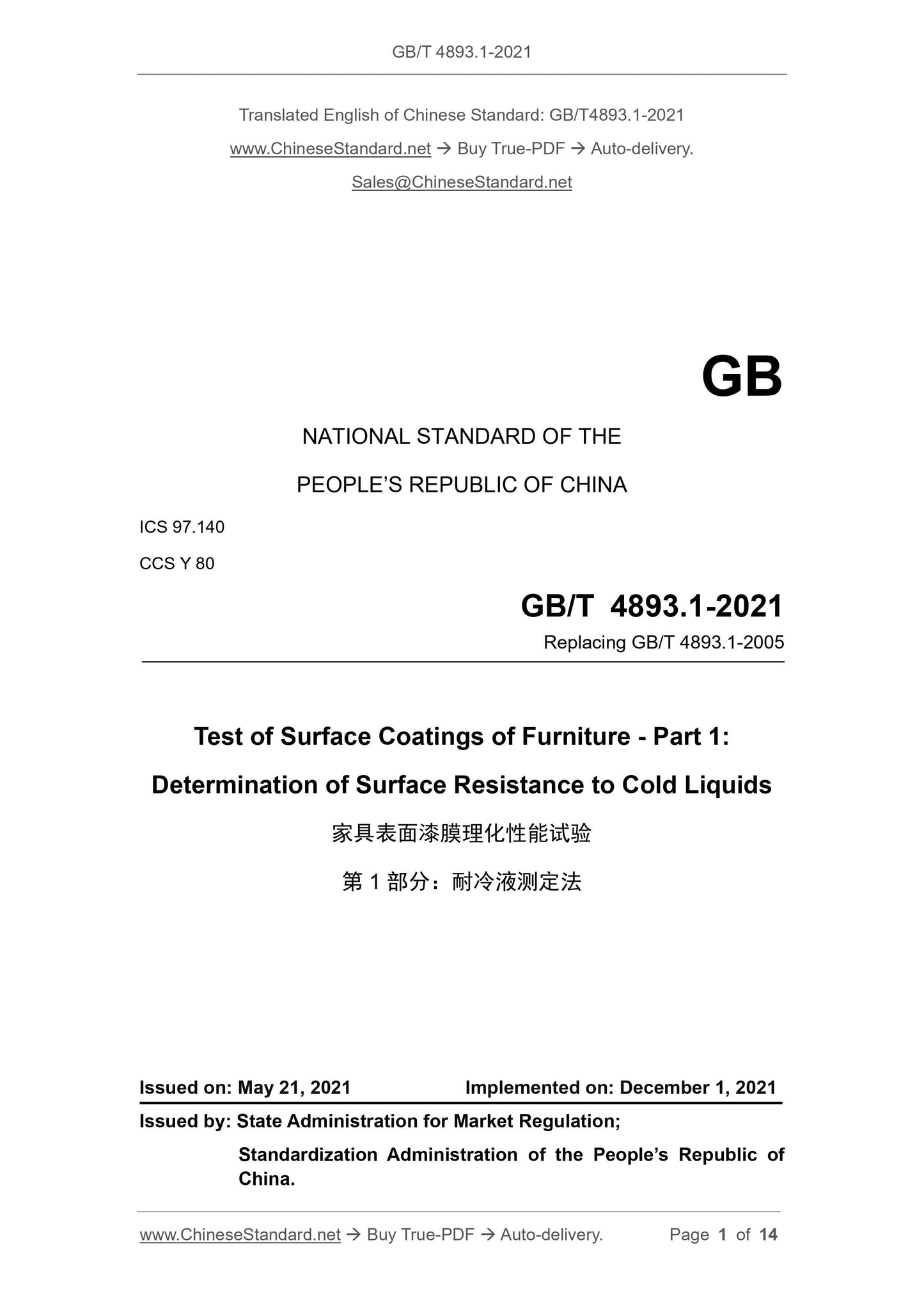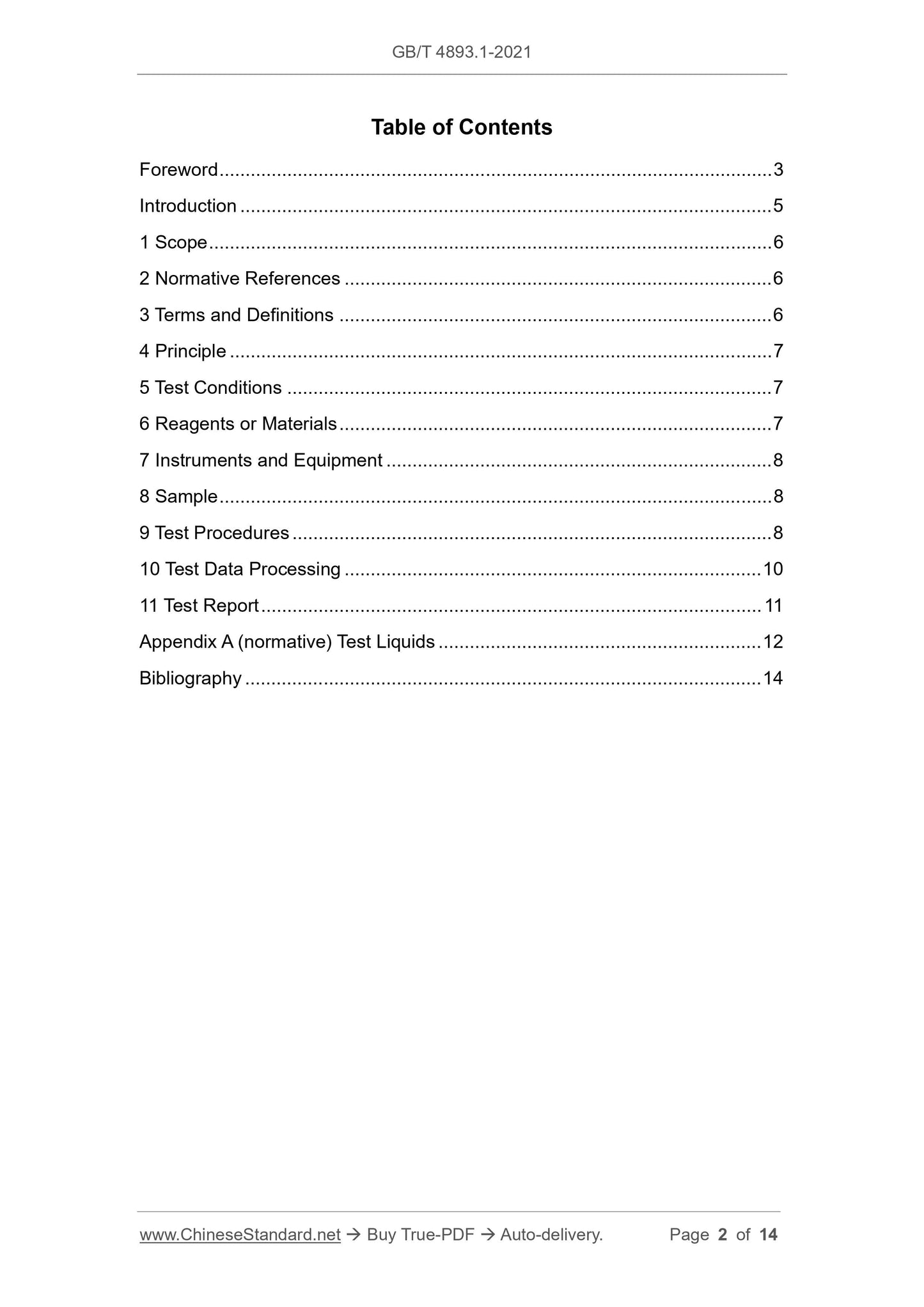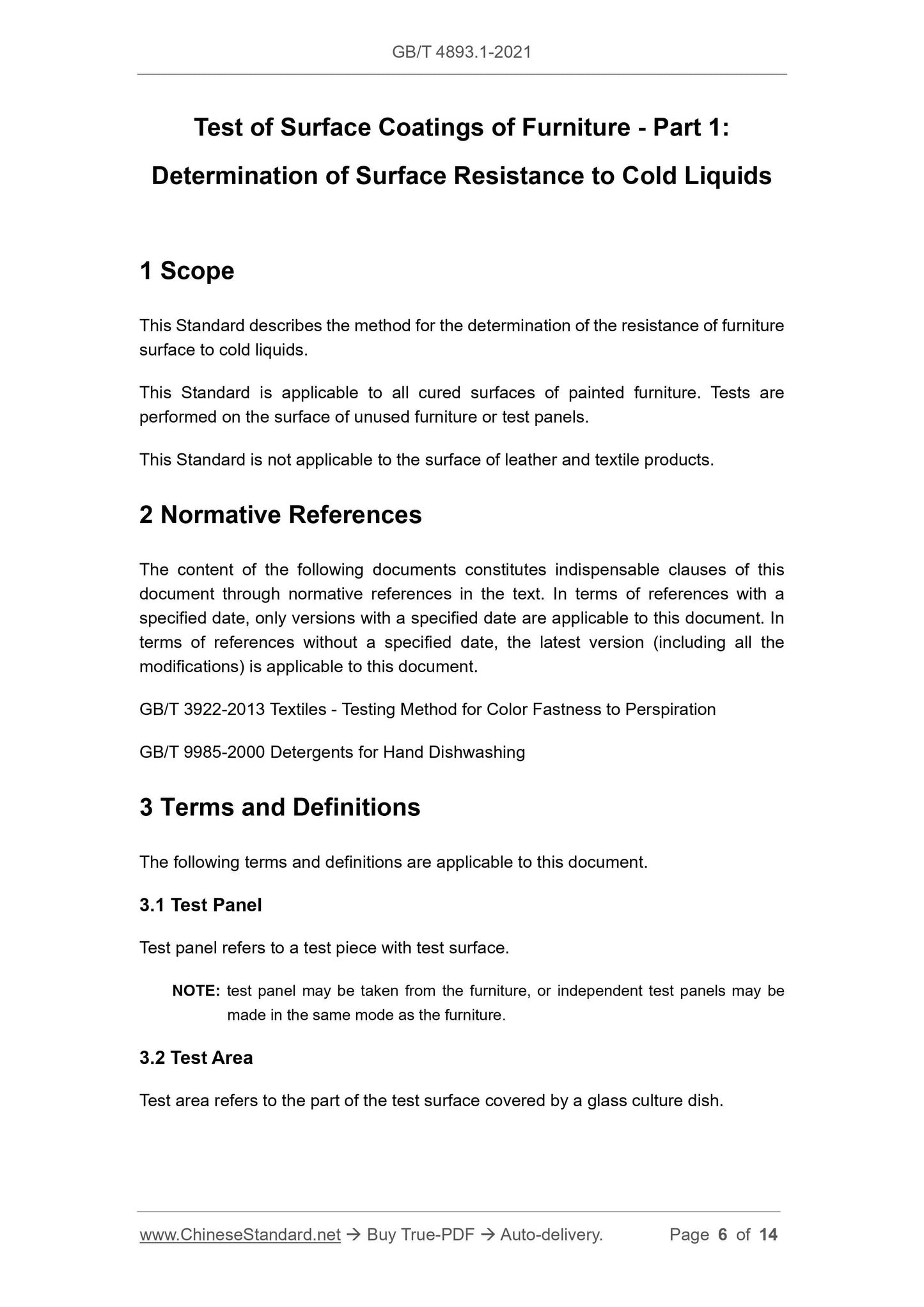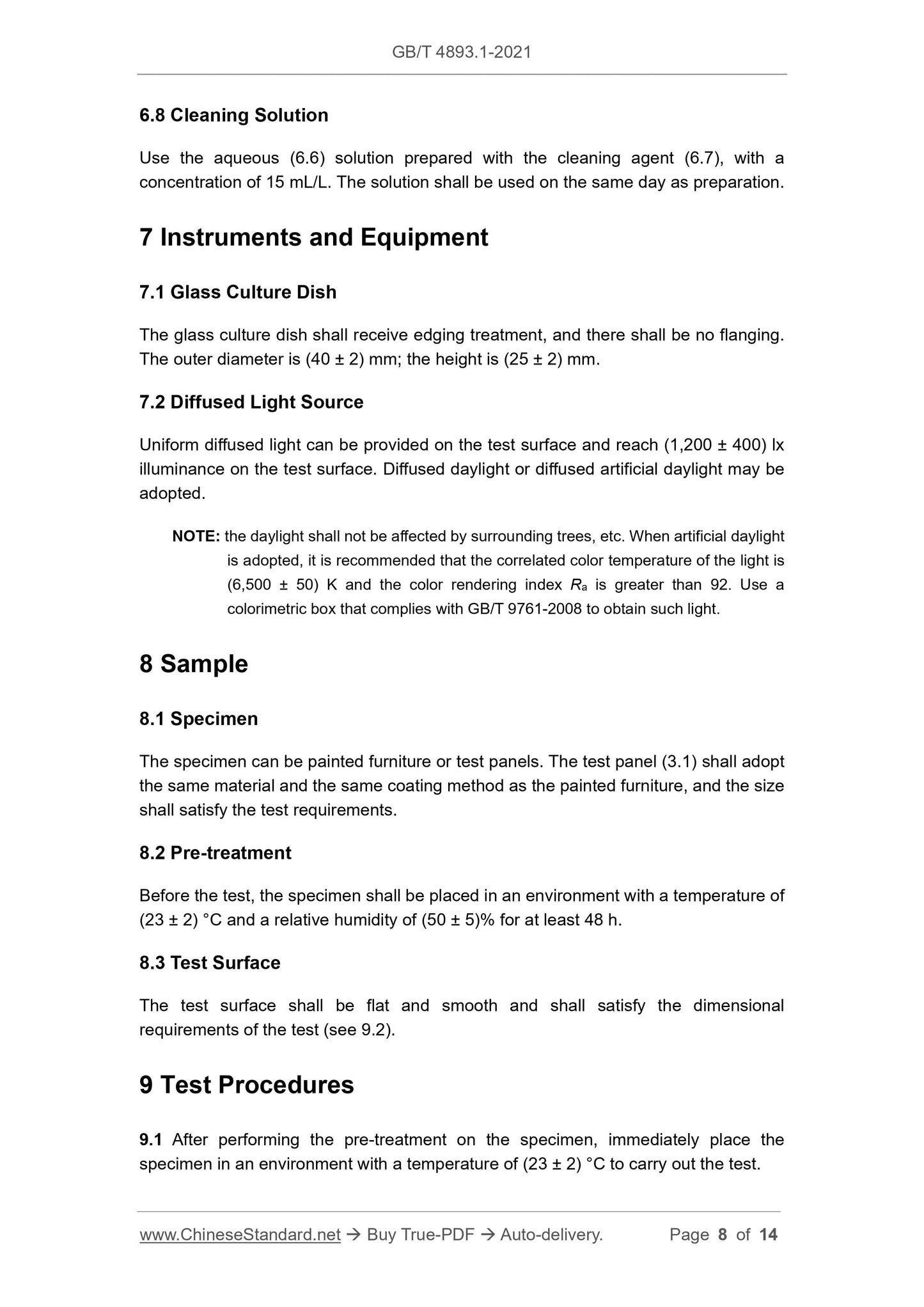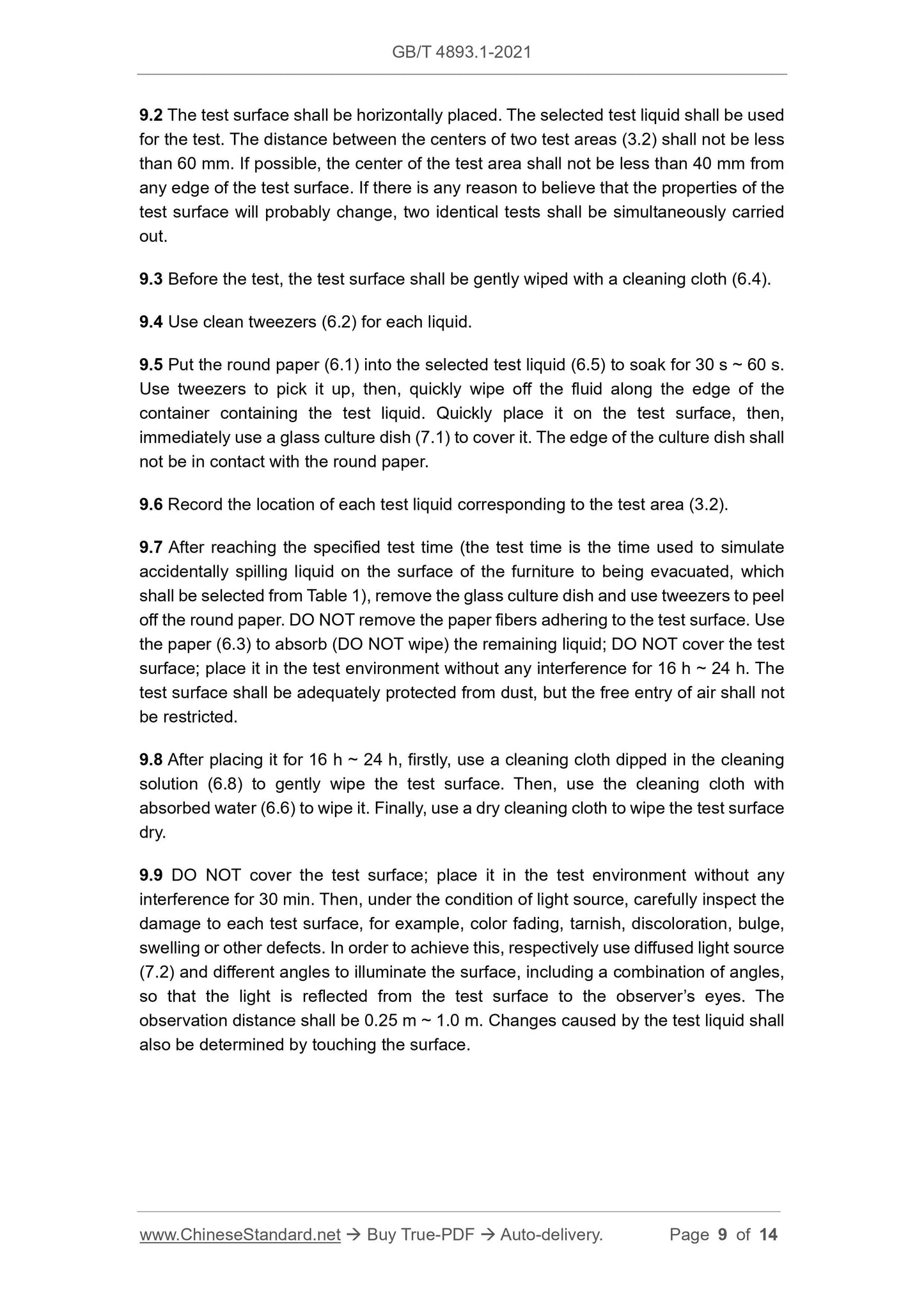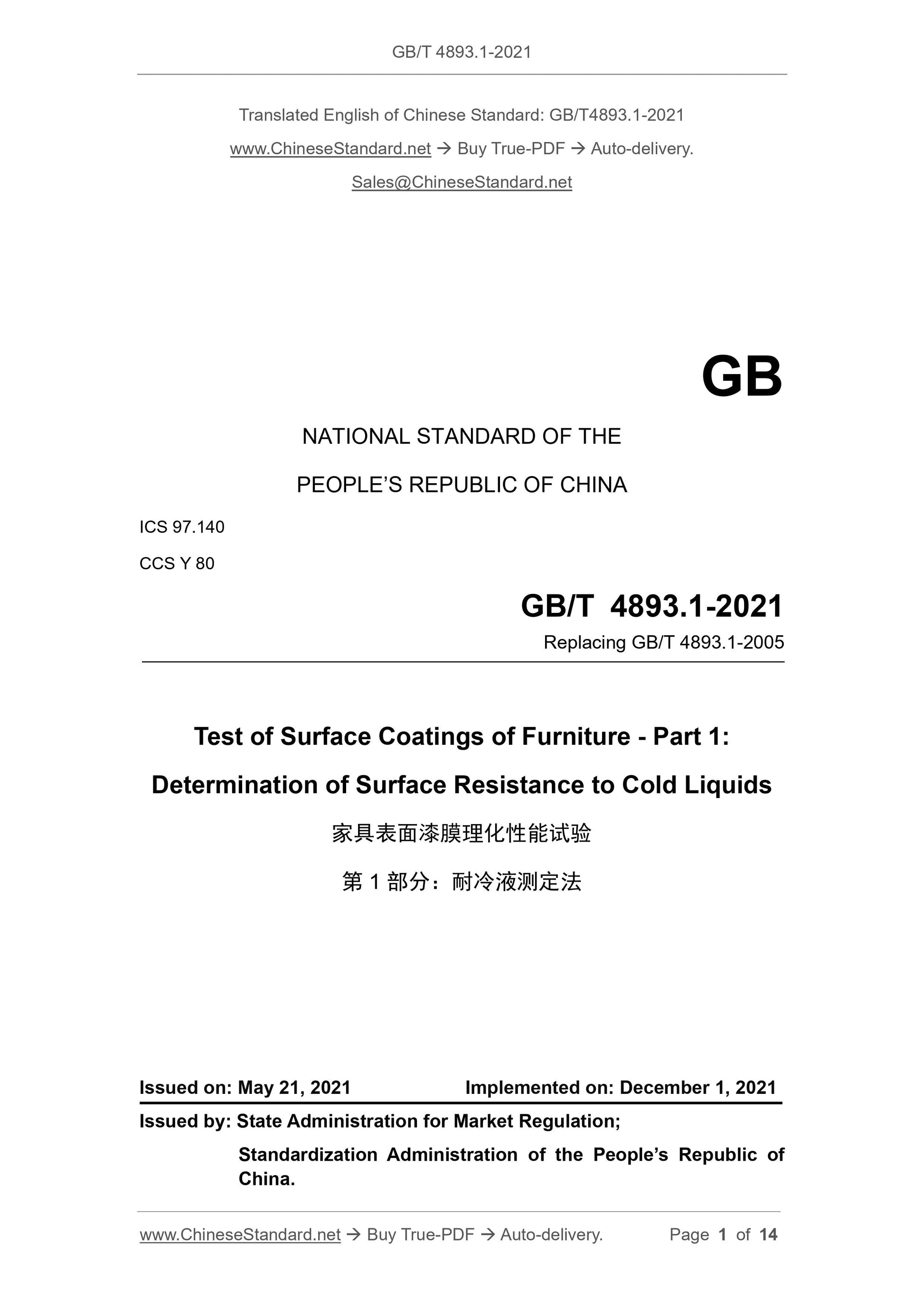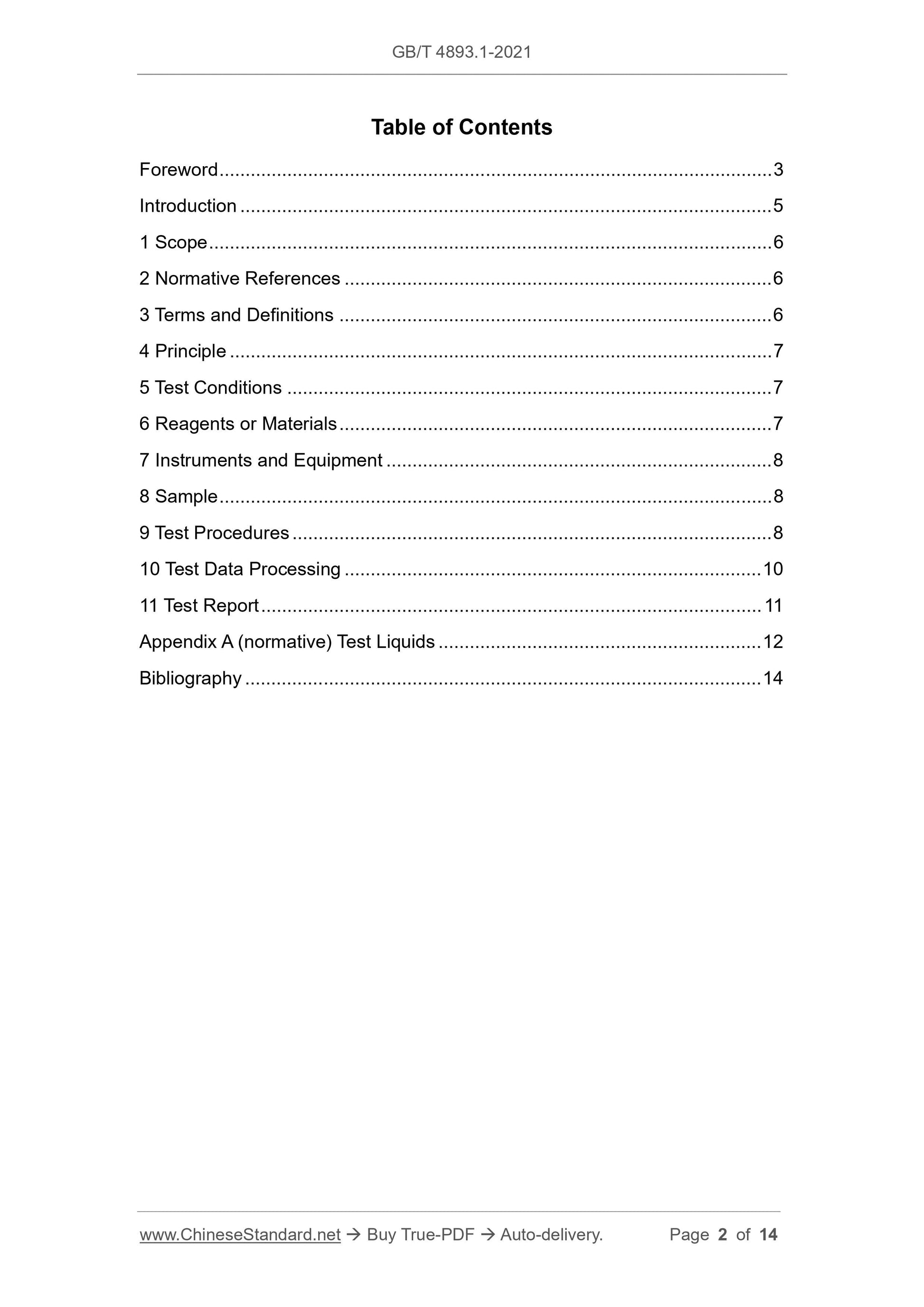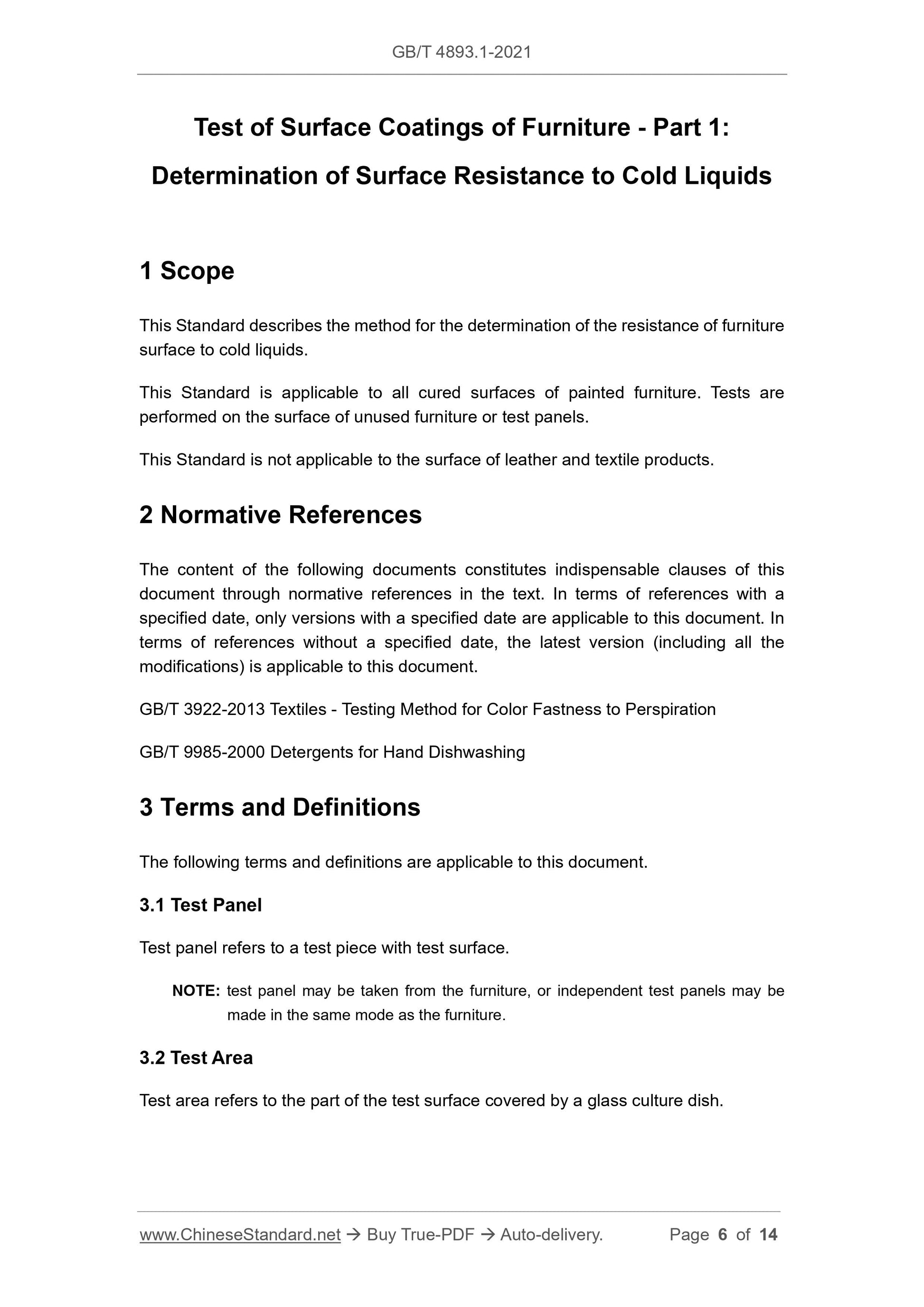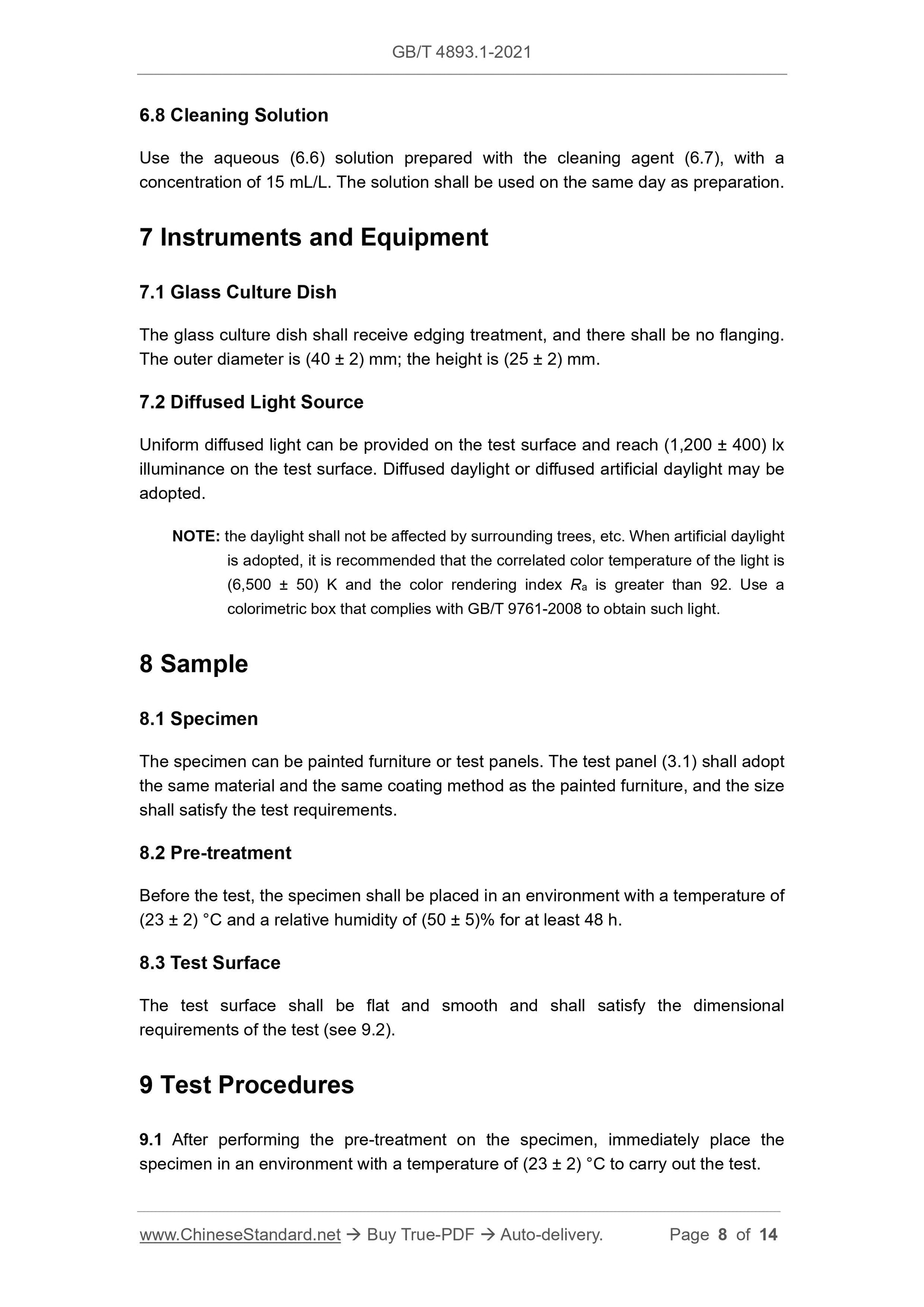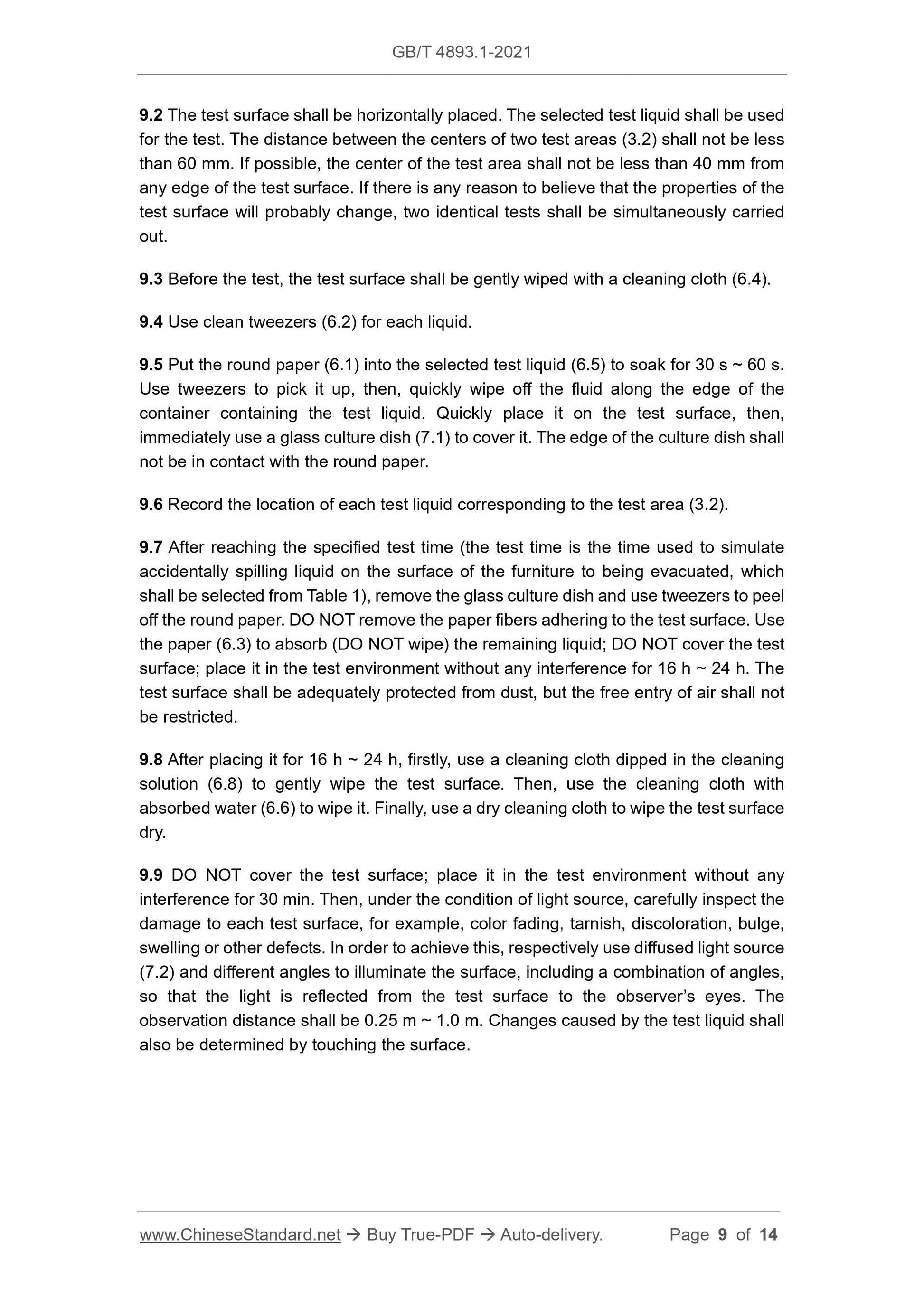1
/
of
5
PayPal, credit cards. Download editable-PDF & invoice in 1 second!
GB/T 4893.1-2021 English PDF (GBT4893.1-2021)
GB/T 4893.1-2021 English PDF (GBT4893.1-2021)
Regular price
$170.00 USD
Regular price
Sale price
$170.00 USD
Unit price
/
per
Shipping calculated at checkout.
Couldn't load pickup availability
Delivery: 3 seconds. Download true-PDF + Invoice.
Get QUOTATION in 1-minute: Click GB/T 4893.1-2021
Historical versions: GB/T 4893.1-2021
Preview True-PDF (Reload/Scroll if blank)
GB/T 4893.1-2021: Test of surface coatings of furniture - Part 1: Determination of surface resistance to cold liquids
GB/T 4893.1-2021
GB
NATIONAL STANDARD OF THE
PEOPLE’S REPUBLIC OF CHINA
ICS 97.140
CCS Y 80
Replacing GB/T 4893.1-2005
Test of Surface Coatings of Furniture - Part 1:
Determination of Surface Resistance to Cold Liquids
ISSUED ON: MAY 21, 2021
IMPLEMENTED ON: DECEMBER 1, 2021
Issued by: State Administration for Market Regulation;
Standardization Administration of the People’s Republic of
China.
Table of Contents
Foreword ... 3
Introduction ... 5
1 Scope ... 6
2 Normative References ... 6
3 Terms and Definitions ... 6
4 Principle ... 7
5 Test Conditions ... 7
6 Reagents or Materials ... 7
7 Instruments and Equipment ... 8
8 Sample ... 8
9 Test Procedures ... 8
10 Test Data Processing ... 10
11 Test Report ... 11
Appendix A (normative) Test Liquids ... 12
Bibliography ... 14
Test of Surface Coatings of Furniture - Part 1:
Determination of Surface Resistance to Cold Liquids
1 Scope
This Standard describes the method for the determination of the resistance of furniture
surface to cold liquids.
This Standard is applicable to all cured surfaces of painted furniture. Tests are
performed on the surface of unused furniture or test panels.
This Standard is not applicable to the surface of leather and textile products.
2 Normative References
The content of the following documents constitutes indispensable clauses of this
document through normative references in the text. In terms of references with a
specified date, only versions with a specified date are applicable to this document. In
terms of references without a specified date, the latest version (including all the
modifications) is applicable to this document.
GB/T 3922-2013 Textiles - Testing Method for Color Fastness to Perspiration
GB/T 9985-2000 Detergents for Hand Dishwashing
3 Terms and Definitions
The following terms and definitions are applicable to this document.
3.1 Test Panel
Test panel refers to a test piece with test surface.
NOTE: test panel may be taken from the furniture, or independent test panels may be
made in the same mode as the furniture.
3.2 Test Area
Test area refers to the part of the test surface covered by a glass culture dish.
6.8 Cleaning Solution
Use the aqueous (6.6) solution prepared with the cleaning agent (6.7), with a
concentration of 15 mL/L. The solution shall be used on the same day as preparation.
7 Instruments and Equipment
7.1 Glass Culture Dish
The glass culture dish shall receive edging treatment, and there shall be no flanging.
The outer diameter is (40 ± 2) mm; the height is (25 ± 2) mm.
7.2 Diffused Light Source
Uniform diffused light can be provided on the test surface and reach (1,200 ± 400) lx
illuminance on the test surface. Diffused daylight or diffused artificial daylight may be
adopted.
NOTE: the daylight shall not be affected by surrounding trees, etc. When artificial daylight
is adopted, it is recommended that the correlated color temperature of the light is
(6,500 ± 50) K and the color rendering index Ra is greater than 92. Use a
colorimetric box that complies with GB/T 9761-2008 to obtain such light.
8 Sample
8.1 Specimen
The specimen can be painted furniture or test panels. The test panel (3.1) shall adopt
the same material and the same coating method as the painted furniture, and the size
shall satisfy the test requirements.
8.2 Pre-treatment
Before the test, the specimen shall be placed in an environment with a temperature of
(23 ± 2) °C and a relative humidity of (50 ± 5)% for at least 48 h.
8.3 Test Surface
The test surface shall be flat and smooth and shall satisfy the dimensional
requirements of the test (see 9.2).
9 Test Procedures
9.1 After performing the pre-treatment on the specimen, immediately place the
specimen in an environment with a temperature of (23 ± 2) °C to carry out the test.
9.2 The test surface shall be horizontally placed. The selected test liquid shall be used
for the test. The distance between the centers of two test areas (3.2) shall not be less
than 60 mm. If possible, the center of the test area shall not be less than 40 mm from
any edge of the test surface. If there is any reason to believe that the properties of the
test surface will probably change, two identical tests shall be simultaneously carried
out.
9.3 Before the test, the test surface shall be gently wiped with a cleaning cloth (6.4).
9.4 Use clean tweezers (6.2) for each liquid.
9.5 Put the round paper (6.1) into the selected test liquid (6.5) to soak for 30 s ~ 60 s.
Use tweezers to pick it up, then, quickly wipe off the fluid along the edge of the
container containing the test liquid. Quickly place it on the test surface, then,
immediately use a glass culture dish (7.1) to cover it. The edge of the culture dish shall
not be in contact with the round paper.
9.6 Record the location of each test liquid corresponding to the test area (3.2).
9.7 After reaching the specified test time (the test time is the time used to simulate
accidentally spilling liquid on the surface of the furniture to being evacuated, which
shall be selected from Table 1), remove the glass culture dish and use tweezers to peel
off the round paper. DO NOT remove the paper fibers adhering to the test surface. Use
the paper (6.3) to absorb (DO NOT wipe) the remaining liquid; DO NOT cover the test
surface; place it in the test environment without any interference for 16 h ~ 24 h. The
test surface shall be adequately protected from dust, but the free entry of air shall not
be restricted.
9.8 After placing it for 16 h ~ 24 h, firstly, use a cleaning cloth dipped in the cleaning
solution (6.8) to gently wipe the test surface. Then, use the cleaning cloth with
absorbed water (6.6) to wipe it. Finally, use a dry cleaning cloth to wipe the test surface
dry.
9.9 DO NOT cover the test surface; place it in the test environment without any
interference for 30 min. Then, under the condition of light source, carefully inspect the
damage to each test surface, for example, color fading, tarnish, discoloration, bulge,
swelling or other defects. In order to achieve this, respectively use diffused light source
(7.2) and different angles to illuminate the surface, including a combination of angles,
so that the light is reflected from the test surface to the observer’s eyes. The
observation distance shall be 0.25 m ~ 1.0 m. Changes caused by the test liquid shall
also be determined by touching the surface.
Get QUOTATION in 1-minute: Click GB/T 4893.1-2021
Historical versions: GB/T 4893.1-2021
Preview True-PDF (Reload/Scroll if blank)
GB/T 4893.1-2021: Test of surface coatings of furniture - Part 1: Determination of surface resistance to cold liquids
GB/T 4893.1-2021
GB
NATIONAL STANDARD OF THE
PEOPLE’S REPUBLIC OF CHINA
ICS 97.140
CCS Y 80
Replacing GB/T 4893.1-2005
Test of Surface Coatings of Furniture - Part 1:
Determination of Surface Resistance to Cold Liquids
ISSUED ON: MAY 21, 2021
IMPLEMENTED ON: DECEMBER 1, 2021
Issued by: State Administration for Market Regulation;
Standardization Administration of the People’s Republic of
China.
Table of Contents
Foreword ... 3
Introduction ... 5
1 Scope ... 6
2 Normative References ... 6
3 Terms and Definitions ... 6
4 Principle ... 7
5 Test Conditions ... 7
6 Reagents or Materials ... 7
7 Instruments and Equipment ... 8
8 Sample ... 8
9 Test Procedures ... 8
10 Test Data Processing ... 10
11 Test Report ... 11
Appendix A (normative) Test Liquids ... 12
Bibliography ... 14
Test of Surface Coatings of Furniture - Part 1:
Determination of Surface Resistance to Cold Liquids
1 Scope
This Standard describes the method for the determination of the resistance of furniture
surface to cold liquids.
This Standard is applicable to all cured surfaces of painted furniture. Tests are
performed on the surface of unused furniture or test panels.
This Standard is not applicable to the surface of leather and textile products.
2 Normative References
The content of the following documents constitutes indispensable clauses of this
document through normative references in the text. In terms of references with a
specified date, only versions with a specified date are applicable to this document. In
terms of references without a specified date, the latest version (including all the
modifications) is applicable to this document.
GB/T 3922-2013 Textiles - Testing Method for Color Fastness to Perspiration
GB/T 9985-2000 Detergents for Hand Dishwashing
3 Terms and Definitions
The following terms and definitions are applicable to this document.
3.1 Test Panel
Test panel refers to a test piece with test surface.
NOTE: test panel may be taken from the furniture, or independent test panels may be
made in the same mode as the furniture.
3.2 Test Area
Test area refers to the part of the test surface covered by a glass culture dish.
6.8 Cleaning Solution
Use the aqueous (6.6) solution prepared with the cleaning agent (6.7), with a
concentration of 15 mL/L. The solution shall be used on the same day as preparation.
7 Instruments and Equipment
7.1 Glass Culture Dish
The glass culture dish shall receive edging treatment, and there shall be no flanging.
The outer diameter is (40 ± 2) mm; the height is (25 ± 2) mm.
7.2 Diffused Light Source
Uniform diffused light can be provided on the test surface and reach (1,200 ± 400) lx
illuminance on the test surface. Diffused daylight or diffused artificial daylight may be
adopted.
NOTE: the daylight shall not be affected by surrounding trees, etc. When artificial daylight
is adopted, it is recommended that the correlated color temperature of the light is
(6,500 ± 50) K and the color rendering index Ra is greater than 92. Use a
colorimetric box that complies with GB/T 9761-2008 to obtain such light.
8 Sample
8.1 Specimen
The specimen can be painted furniture or test panels. The test panel (3.1) shall adopt
the same material and the same coating method as the painted furniture, and the size
shall satisfy the test requirements.
8.2 Pre-treatment
Before the test, the specimen shall be placed in an environment with a temperature of
(23 ± 2) °C and a relative humidity of (50 ± 5)% for at least 48 h.
8.3 Test Surface
The test surface shall be flat and smooth and shall satisfy the dimensional
requirements of the test (see 9.2).
9 Test Procedures
9.1 After performing the pre-treatment on the specimen, immediately place the
specimen in an environment with a temperature of (23 ± 2) °C to carry out the test.
9.2 The test surface shall be horizontally placed. The selected test liquid shall be used
for the test. The distance between the centers of two test areas (3.2) shall not be less
than 60 mm. If possible, the center of the test area shall not be less than 40 mm from
any edge of the test surface. If there is any reason to believe that the properties of the
test surface will probably change, two identical tests shall be simultaneously carried
out.
9.3 Before the test, the test surface shall be gently wiped with a cleaning cloth (6.4).
9.4 Use clean tweezers (6.2) for each liquid.
9.5 Put the round paper (6.1) into the selected test liquid (6.5) to soak for 30 s ~ 60 s.
Use tweezers to pick it up, then, quickly wipe off the fluid along the edge of the
container containing the test liquid. Quickly place it on the test surface, then,
immediately use a glass culture dish (7.1) to cover it. The edge of the culture dish shall
not be in contact with the round paper.
9.6 Record the location of each test liquid corresponding to the test area (3.2).
9.7 After reaching the specified test time (the test time is the time used to simulate
accidentally spilling liquid on the surface of the furniture to being evacuated, which
shall be selected from Table 1), remove the glass culture dish and use tweezers to peel
off the round paper. DO NOT remove the paper fibers adhering to the test surface. Use
the paper (6.3) to absorb (DO NOT wipe) the remaining liquid; DO NOT cover the test
surface; place it in the test environment without any interference for 16 h ~ 24 h. The
test surface shall be adequately protected from dust, but the free entry of air shall not
be restricted.
9.8 After placing it for 16 h ~ 24 h, firstly, use a cleaning cloth dipped in the cleaning
solution (6.8) to gently wipe the test surface. Then, use the cleaning cloth with
absorbed water (6.6) to wipe it. Finally, use a dry cleaning cloth to wipe the test surface
dry.
9.9 DO NOT cover the test surface; place it in the test environment without any
interference for 30 min. Then, under the condition of light source, carefully inspect the
damage to each test surface, for example, color fading, tarnish, discoloration, bulge,
swelling or other defects. In order to achieve this, respectively use diffused light source
(7.2) and different angles to illuminate the surface, including a combination of angles,
so that the light is reflected from the test surface to the observer’s eyes. The
observation distance shall be 0.25 m ~ 1.0 m. Changes caused by the test liquid shall
also be determined by touching the surface.
Share
